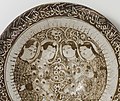Naskh (script)

| Part of a series on |
| Islamic culture |
|---|
| Architecture |
| Art |
| Clothing |
| Holidays |
| Literature |
| Music |
| Theatre |
Naskh[a] is a smaller, round script of Islamic calligraphy. Naskh is one of the first scripts of Islamic calligraphy to develop, commonly used in writing administrative documents and for transcribing books, including the Qur’an, because of its easy legibility.[1]
In his 1617 Grammatica Arabica, Thomas van Erpe defined naskhī characters as the "noblest and true writing style".[2]
Origin
[edit]The Naskh style of writing can be found as early as within the first century of the Islamic calendar.[3]
Round scripts became the most popular in the eleventh, twelfth and thirteenth centuries, due to their use by scribes.[1]
Ibn Muqla is credited with standardizing the "Six Pens" of Islamic calligraphy, also including thuluth, tawqi’, riqaaʿ, muhaqqaq, and rayhani.[1] These are known as "the proportioned scripts" (al-khatt al-mansub) or "the six scripts" (al-aqlam al-sitta).[4]
Kufic is commonly believed to predate naskh, but historians have traced the two scripts as coexisting long before their codification by ibn Muqla,[5] as the two served different purposes.[6] Kufi was used primarily in decoration, while Naskh served for everyday scribal use.[7], It is believed that Ibn Muqla developed the Naskh script, but did not invent it[8]
Description
[edit]The alif is written as a straight stroke, bending to the lower left.[1] Naskh differentiates various sounds through the use of diacritical points, in the form of 1–3 dots above or below the letter, which makes the script more easily legible.[6] Naskh uses a horizontal base line; in situations where one character starts within the tail of the preceding letter, the base line is broken and raised.[9] In sixteenth-century Constantinople, Şeyh Hamdullah (1429–1520) redesigned the structure of naskh, along with the other "Six Pens", in order to make the script appear more precise and less heavy.[10]
Use
[edit]The script is what is normally used electronically and as the default typeface. Examples on typefaces in naskh on Windows (W), iOS (M), Linux (L), and Google Fonts (G):
- Arial(W/M) (Arabic Transparent,(W) Times New Roman)(W/M)
- Simplified Arabic(W)
- Courier New(W/M) (monospace)
- Damascus(M)
- Noto Naskh Arabic(G)
- SF Arabic(M)[11]
Naskh was historically used heavily in the transcription of books and in administrative courtly documents.[7]
Naskh allowed for the development of decorative elements into more supple, rounded designs, away from the common use of squared kufic in decoration. Naskh's use in architecture first began in the tenth century and had been adopted in many Muslim countries by the eleventh century.[7]
Mixed use with Ruqʿah style
[edit]- KacstOne(L)
- Arabic Typesetting(W)
- Al Bayan(M)
- DecoType Naskh(M)
- Baghdad(M)
- Geeza Pro(M)
- Nadeem(M)
- Sakkal Majalla(W)
- Traditional Arabic(W)
- Amiri(G)
More recently, fonts, such as the Bulaq Press-inspired Amiri typeface or Monotype Imaging's Bustani font, have created user-friendly digital manifestations of naskh for use in graphic design and digital typography, mixed with Ruqʿah.[12][13]
Gallery
[edit]-
14th- or 15th-century Quran with body text in naskh
-
Stonepaste dish from 13th century Iran with a poem in naskh around the rim.
See also
[edit]- Ruqʿah (the cursive Arabic handwriting)
- Nastaliq
- Arabic, Urdu, other Arabic keyboard layouts
- National Language Authority
- Taʿlīq script
Notes
[edit]References
[edit]- ^ a b c d Blair, Sheila (2006). Islamic calligraphy. Edinburgh: Edinburgh University Press. ISBN 9780748612123. OCLC 56651142.
- ^ Thomas Milo Arabic Typography, in Encyclopedia of Arabic Language and Linguistics, Brill 2013
- ^ بىاض, Anjuman-e-Farsi, 1977, p. 77
- ^ Roxburgh, David J. (2007). Writing the word of God: calligraphy and the Qur'an. Houston: Museum of Fine Arts, Houston. ISBN 9780300142006. OCLC 180190749.
- ^ "Naskh Script- Arabic calligraphy". 2017-01-24. Retrieved 2024-10-08.
- ^ a b Ali, A. K. M. Yaqub (1984). "Muslim Calligraphy: ITS Beginning and Major Styles". Islamic Studies. 23 (4): 373–379. JSTOR 20847281.
- ^ a b c The splendor of Islamic Abdelkebir. Sijelmassi, Mohamed. New York: Thames and Hudson. 1996. ISBN 0500016755. OCLC 34275017.
{{cite book}}: CS1 maint: others (link) - ^ "Naskhī script | Arabic, Islamic, Writing | Britannica". www.britannica.com. Retrieved 2024-09-26.
- ^ Ory, Solange (2000-11-30). "Calligraphy". Encyclopaedia of the Qurʾān. 1.
- ^ Zakariya, Muhammad (2003-11-30). "Calligraphy". Encyclopedia of the Modern Middle East and North Africa. 1.
- ^ "Fonts for Apple Platforms". Retrieved 14 February 2022.
- ^ "مشروع الخط الأميري :: Amiri Font Project". www.amirifont.org. Retrieved 2020-01-29.
- ^ Blair, Sheila; Bloom, Jonathan M., eds. (2017). By the Pen and what They Write: Writing in Islamic Art and Culture. New Haven: Yale University Press. ISBN 9780300228243. OCLC 971615736.



